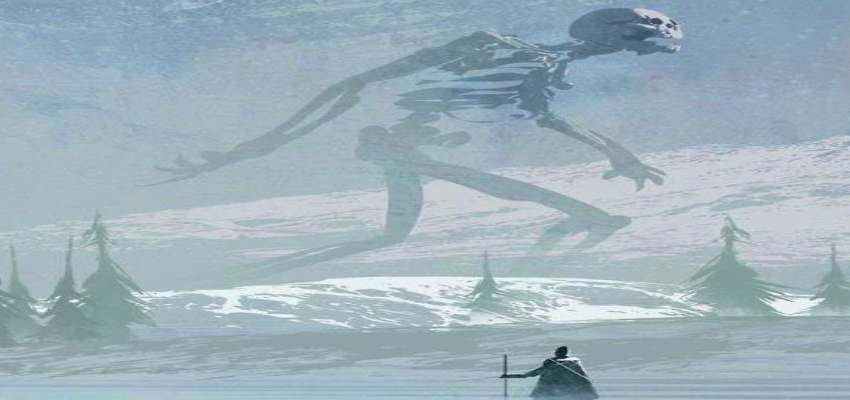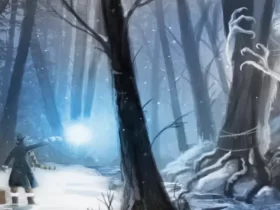Ithaqua is a supernatural entity created by writer H.P. Lovecraft in the shared universe of cosmic horror known as the “Cthulhu Mythos”.
Ithaqua is a monstrous entity from H.P. Lovecraft’s cosmic horror universe known as the “Cthulhu Mythos”. It is considered one of the powerful Great Old Ones and takes the form of a giant with a human-like shape and blazing red eyes. Ithaqua is known to roam the Arctic and Sub-Arctic regions and is infamous for hunting and killing unsuspecting travelers. Native American legends of the Wendigo and possibly the Yeti are thought to have been inspired by encounters with Ithaqua.
Ithaqua’s Cult

Ithaqua has a small following of devoted worshippers, but is widely feared in northern regions like Siberia, Canada, and Alaska. People in these areas often leave offerings for Ithaqua as a form of appeasement, not worship. Those who join Ithaqua’s cult are said to be protected from extremely cold temperatures. Ithaqua is known to use the massive bird-like creatures called Shantaks as servants.
Ithaqua In “Titus Crow Mythos”

Ithaqua plays a significant role in Brian Lumley’s “Titus Crow Mythos” series, where he is depicted as the ruler of the ice world of Borea. In these works, Ithaqua travels through the winds of space between Earth and Borea, capturing and bringing victims back to worship it in Borea’s frozen wasteland.
Ithaqua often tries to breed with humanoid women in an attempt to create offspring that surpass its own limitations, which were imposed by the Elder Gods, with the goal of freeing the other Great Old Ones. It is speculated that Ithaqua’s ultimate desire is to have children to alleviate its loneliness as the only being of its kind and in the hopes of creating offspring with superior abilities. However, none of its offspring have ever lived up to Ithaqua’s expectations, ultimately turning against it at some point.
Must Read: Kthanid (Member Of Elder Gods & Brother Of Cthulhu) Explained With Story
Those who are caught by Ithaqua are taken to its true home, the ice planet of Borea, where they are added to its growing group of followers. Ithaqua is a massive humanoid with webbed feet and glowing red eyes that frequently roams the Arctic wilderness in search of prey. It is believed to be the source of legends about the Wendigo and Yeti. Those who live in Ithaqua’s hunting territory often make regular offerings to this fearsome entity, not out of devotion, but in an attempt to appease it and avoid its wrath.
Along with his cult on Borea, Ithaqua has the use of the massive avian creatures called Shantaks who live in the Dreamlands, and has access to powerful air elementals. Ithaqua was also worshipped by a race of cannibalistic subhumans called the Gnophkeh, until they were destroyed during an ice age caused by Ithaqua and Aphoom-Zhah.
Ithaqua was solely responsible for the annihilation of every human entity of an entire Swedish army in 1718 during the Carolean Death March. Additionally, Ithaqua made two attempts to kill Titus Crow, a long-time adversary of the Great Old Ones. The first attempt involved sending powerful elementals to attack Crow in his own home, but he and his friend were able to escape using the time machine called “De Marigny’s Clock.” The second time, Ithaqua went after Crow himself while he was traveling through the cosmos in the Clock, but Titus Crow was able to use the machine’s weapons to defend himself against the monster.
Races That Obeys Or Worship Ithaqua
Ithaqua is often served by creatures called Shantaks, which are described as large, slimy birds with bat-like wings that are bigger than elephants. They were first mentioned by Randall Carter in H.P. Lovecraft’s “The Dream-Quest of Unknown Kadath” and are said to reside in the Dreamlands, where they are hunted by Nodens and have a fear of Nightgaunts.
The Gnophkehs, who are known for their cannibalistic tendencies, are reported to pay homage to Ithaqua along with Aphoom-Zham and Rhan-Tegoth.
Ithaque Legends & Stories

“The Thing that Walked on the Wind” – A Story That Highlights The Ithaqua Terror
In “The Thing that Walked on the Wind” (Strange Tales, January 1933), the author Derleth introduces the Ithaqua monster. The story revolves around a Mountie named Dalhousie who is investigating a mysterious case in the towns of Navissa Camp, Manitoba and Stillwater. The local doctor finds three bodies that have fallen from the sky. The first, a woman, is frozen solid, while the other two, men, are still alive but die from the warmth of the room. Dalhousie pieces together that the three people were strangers who had come to Stillwater, and the woman had come to them for help as the townspeople wanted to sacrifice her to their Wind walker – The Ithaqua. When Ithaqua took the three, he also took all of the townspeople in retaliation. The Mountie discovers the creature, described as a strange purplish snow cloud and burning eyes. After this encounter, he feels like he is being watched and wishes to escape. This is how the report ended.
Ithaqua (Strange Stories, February 1941)
In “Ithaqua” (Strange Stories, February 1941), a Mountie investigates the disappearance of a man named Henry Lucas, who left behind mysterious tracks. The priest leads the constable to find three circular stone altars and signs of big bonfires in the woods. The constable encounters Ithaqua before running back to the town of Cold Harbour.
“Beyond the Threshold” is the final Ithaqua story by Derleth and was published in Weird Tales (September 1941), a magazine that served as the birthplace of most of the Mythos. Unlike the previous two Derleth tales, this story begins as a Deep One story and gradually transforms into an Ithaqua story, which makes it structurally different. Anthony Alwyn arrives at his grandfather’s house after being summoned by his cousin Frolin. The grandfather has been acting strangely and strange music has been heard coming from his study. The cousins discover that the grandfather has uncovered old evidence from their ancestor Leander Alwyn about Ithaqua and a hidden “threshold” that he wants to cross. When he finally does, he ends up being carried off and frozen to death, like all those who have seen Ithaqua, and his body is dropped far away from home. The story only adds the idea that the Great Old Ones, such as Ithaqua, are elementals of air, while others like Cthulhu are water elementals. This idea would later be explored by Brian Lumley in his Titus Crow novels, but Lumley’s more detailed explanations and overexposure of the horror made the wind-walker more well-rounded but less frightening.
Ithaqua And Wendigo Fictional Connection

In Native American mythology, the wendigo is a creature that possesses characteristics of both a vampire and a werewolf. The creature is associated with breaking the taboo of cannibalism, with belief that those who engage in this practice would turn into a wendigo. These wind walkers are considered supernatural beings that hunt for human flesh and have the ability to suddenly appear, similar to a European vampire. However, the wendigo is depicted as a monstrous figure to its victims, which is why it is also compared to the werewolf.
The Algonquin-speaking tribes in the northern United States and First Nations tribes in Canada, such as the Ojibwe and Cree, have stories of the wendigo. The idea of “wendigo psychosis” was a psychological condition that some indigenous people of North America would experience where they would crave human flesh but fear turning into the monster. This fear was due to the harsh winter conditions in their northern environment that could lead to starvation, which led to a strong taboo against cannibalism. It was believed that once someone tasted human flesh, their craving would become insatiable and supernatural, leading to the idea that it was better to die than turn into a wendigo through cannibalism.
Wrapping Up
Ithaqua is considered a powerful and malevolent force in the Mythos, known for its ability to traverse the cosmos and terrorize human civilizations. It is worshiped by various cults as a deity and is said to reside in the cold and desolate regions of the Arctic. Ithaqua is often associated with other deities from the Mythos, such as the Great Old One Cthulhu. Overall, Ithaqua serves as a representation of the cosmic indifferent nature of the universe and the fear it inspires in humanity.
References:
- The Transition of Titus Crow Grafton
- Introduction: Ghost Riders in the Sky
- “Born of the Winds”. Fruiting Bodies and Other Fungi Tor
- The Thing that Walked on the Wind 1933




